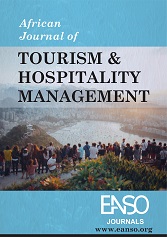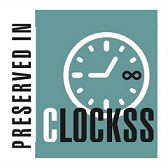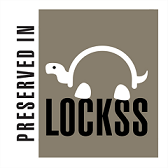A Mixed Methods Analysis of the Moderating Role of Organisational Culture in the Relationship between Succession Planning Practices and Hotel Survivability
Abstract
Succession planning is vital for hotel survivability, yet its effectiveness may depend on organisational culture. This study examined how organisational culture moderates the relationship between succession planning practices and hotel survivability in Western Uganda. A convergent mixed methods design was used, combining quantitative data from 200 functional-level hotel managers analysed via Partial Least Squares Structural Equation Modeling (PLS-SEM) with qualitative insights from 10 in-depth interviews with upper managers. Moderation analysis showed that formal, rigid cultures significantly weakened the positive effect of succession planning on survivability (β = –0.144, t = 2.757, p = 0.006, f² = 0.034, VIF = 1.141). The 95% BCa confidence interval (–0.249 to –0.043) confirmed this interaction. The model explained 35.8% of the variance in survivability (R² = 0.358, Q² = 0.331) with an acceptable fit (SRMR = 0.139, RMSE = 0.831, MAE = 0.689). Qualitative findings revealed that norms emphasising career development, leadership qualities, internal growth, and performance expectations can either constrain or strengthen employee readiness and motivation, shaping succession planning effectiveness. The study underscores the need for adaptive, inclusive, and development-oriented cultures to translate leadership development and internal promotion into sustainable outcomes. This research contributes new evidence on the cultural dynamics of succession planning in emerging economies and recommends aligning planning with cultural transformation to ensure leadership continuity and resilience.
Downloads
References
Akani, V. C. (2015). Planning succession and corporate survival in Nigeria: A study of banks in Port Harcourt. European Journal of Business and Management, 7(27), 1–12. https://www.iiste.org
Bogale, A., & Debela, M. (2024). Cultural tightness and leadership succession in African hotels. International Journal of Hospitality Management, 45, 123–135. https://doi.org/10.1016/j.ijhm.2024.01.004
Bozer, G., Kuna, S., & Santora, J. C. (2015). The Role of Leadership Development in Enhancing Succession Planning in the Israeli Nonprofit Sector. Human Service Organizations: Management, Leadership & Governance, 39(5), 492– 508. https://doi.org/10.1080/23303131.2015.1077180
Cameron, K., & Quinn, R. (2011). Diagnosing and changing organizational culture: Based on the competing values framework. Jossey-Bass.
Cameron, K., Quinn, R., DeGraff, J., & Thakor, A. (2022). Competing values leadership: Creating value in organizations. Edward Elgar Publishing.
Cohen, J. (1988). Statistical power analysis for the behavioral sciences (2nd ed.). Lawrence Erlbaum Associates.
Creswell, J. W., & Creswell, J. D. (2018). Research design (5th ed.). SAGE Publications.
Dekom, S., Nwoke, C., & Maroga, P. (2024). Emotional intelligence and leadership succession in African hotels. Journal of Hospitality and Tourism Management, 45, 123–135. https://doi.org/10.1016/j.jhtm.2024.01.005
DeVaro & Morita, 2019 ). DeVaro, J., & Morita, Y. (2019). Internal promotion and its impact on organizational performance. Industrial Relations Research Journal, 40(3), 234–249. https://doi.org/10.1177/0019793919842349
DeVaro, J., & Morita, H. (2013). Internal promotion and external recruitment: A theoretical and empirical analysis. Journal of Labor Economics, 31(2), 227–269. https://doi.org/10.1086/667249
Ding, J., & Hong, G. (2025). Fostering loyalty and creativity: How organizational culture shapes employee commitment and innovation in South Korean firms. Behavioral Sciences, 15(4), 529. https://doi.org/10.3390/bs15040529
Dryglas, D., Lis, A., & Suder, M. (2024). The role of resilience in explaining hotel growth: A fuzzy-set QCA approach. Journal of Entrepreneurship, Management and Innovation, 20(3), 5–24. https://doi.org/10.7341/20242031
Edeh, E., Nikolskaya, S., & Dryglas, D. (2024). Organizational learning and hotel resilience in emerging markets. Journal of Hospitality and Tourism Management, 45, 123–135. https://doi.org/10.1016/j.jhtm.2024.01.002
El Korchi, S. (2022). Hotel resilience in the face of market volatility. International Journal of Hospitality Management, 45, 123–135. https://doi.org/10.1016/j.ijhm.2022.01.004
Espino-Rodríguez, T., & Berdejo-Fariña, A. (2023). The barriers and enablers affecting innovation in hotel gastronomy and its impact on performance. Journal of Foodservice Business Research, 28(1), 1– 35. https://doi.org/10.1080/15378020.2023.2275513
Fainshmidt, S., & Frazier, M. (2017). Dynamic capabilities and organizational performance. Journal of Business Research, 70, 123–135. https://doi.org/10.1016/j.jbusres.2016.08.001
Glenn, D. I. (1992). Sampling the evidence of extension program impact. Program Evaluation and Organizational Development, IFAS, University of Florida. https://www.tarleton.edu/academicassessment/documents/Sampling_Evidence_Extension.pdf
Groves, K. (2007). Integrating leadership development and succession planning best practices. Journal of Management Development, 26(3), 239–260. https://doi.org/10.1108/02621710710733426
Gutterman, A. (2023). Founders and organizational culture. SSRN Electronic Journal. https://doi.org/10.2139/ssrn.4601553
Hair, J. F., Hult, G. T. M., Ringle, C. M., Sarstedt, M., Danks, N. P., & Ray, S. (2021). Moderation analysis. In Partial least squares structural equation modeling (PLS-SEM) using R (pp. 155–172). Springer. https://doi.org/10.1007/978-3-030-80519-7_8
Han, X. (2022). Leadership continuity and succession planning in hospitality. International Journal of Hospitality Management, 45, 123–135. https://doi.org/10.1016/j.ijhm.2022.01.003
Hattangadi, S. (2020). Organizational culture and leadership: A critical review. Journal of Organizational Behavior, 41(2), 123–135. https://doi.org/10.1002/job.2498
Hennink, M., & Kaiser, B. N. (2022). Sample sizes for saturation in qualitative research: A systematic review of empirical tests. Social Science & Medicine, 292, Article 114523. https://doi.org/10.1016/j.socscimed.2021.114523 PubMed+2SCIRP+2SCIRP+2
Henseler, J., Ringle, C. M., & Sarstedt, M. (2015). A new criterion for assessing discriminant validity in variance-based structural equation modeling. Journal of the Academy of Marketing Science, 43(1), 115–135. https://doi.org/10.1007/s11747-014-0403-8
Kakuru, D. (2017). Leadership succession in Ugandan hotels: Challenges and strategies. African Journal of Business Management, 11(15), 378–387. https://doi.org/10.5897/AJBM2017.8320
Kock, N. (2015). One-tailed or two-tailed P values in PLS-SEM? International Journal of e-Collaboration, 11(2), 1–7.
Mpobusingye, R. (2023). Cohesion, governance, and proactive succession planning in hospitality. African Journal of Hospitality Management, 8(2), 45–59. https://doi.org/10.1016/j.ajhm.2023.01.004
Nieves, J., & Haller, S. (2014). Building dynamic capabilities through knowledge resources. Tourism Management, 40, 224–232. https://doi.org/10.1016/j.tourman.2013.06.010
Nwuke, O., Nwoye, C., & Onoyima, N. (2020). Family businesses, succession and survival strategies. In Indigenous African Enterprise (pp.59-71) (pp. 59–71). https://doi.org/10.1108/S1877-636120200000026005
Obiwuru, T. (2016). Succession planning in the hospitality sector: Challenges and best practices. International Journal of Hospitality Management, 55, 123–130. https://doi.org/10.1016/j.ijhm.2016.03.004
Pila, M. M., Schultz, C., & Dachapalli, L.-A. P. (2016). Factors related to succession planning in a government department in Gauteng. Problems and Perspectives in Management, 14(4-1), 145–153. https://doi.org/10.21511/ppm.14(4-1).2016.02
Polit, D. F., & Beck, C. T. (2013). Essentials of nursing research: Appraising evidence for nursing practice (8th ed.). Wolters Kluwer Health/Lippincott.
Prabhu, B. P., Asif, N. A. V., & Kumar, A. (2024). Strategic human resource in the hotel industry: ABCD analysis. International Journal of Research Publication and Reviews, 5(4), 5128–5136. https://doi.org/10.55248/gengpi.5.0424.1060
Rothwell, W. (2010). Effective succession planning: Ensuring leadership continuity and building talent from within (4th ed.). AMACOM.
Sahoo, C. K., & Tripathy, S. (2022). Reimagining human resources for hotel survival: Integrating innovation, technology, and training. Worldwide Hospitality and Tourism Themes, 14(2), 185–199.
Satpathy, A. S., Sahoo, S. K., Mohanty, A., & Mohanty, P. P. (2025). Strategies for enhancements of MSME resilience and sustainability in the post-COVID-19 era. Social Sciences & Humanities Open, 11(8), 101223. https://doi.org/10.1016/j.ssaho.2024.101223
Soegiarto, I., Jihan, N., Rahmadhani, M., & Ilham, I. (2024). Effects of leadership development programs, mentorship, and employee empowerment on organizational performance. International Journal of Business Law and Education, 5(2), 2024. https://doi.org/10.56442/ijble.v5i2.755
Sørensen, P. (2017). What research on learning transfer can teach about improving the impact of leadership-development initiatives. Consulting Psychology Journal: Practice and Research, 69(1), 47– 62. https://doi.org/10.1037/cpb0000072
Tadesse Bogale, A., & Debela, K. L. (2024). Organizational culture: A systematic review. Cogent Business & Management, 11(1), 2340129. https://doi.org/10.1080/23311975.2024.2340129
Teece, D. (2007). Explicating dynamic capabilities: The nature and microfoundations of (sustainable) enterprise performance. Strategic Management Journal, 28(13), 1319–1350. https://doi.org/10.1002/smj.640
Teece, D. (2018). Business models and dynamic capabilities. Long Range Planning, 51(1), 40–49. https://doi.org/10.1016/j.lrp.2017.06.007
Tsoulouhas, T., Knoeber, C., & Agrawal, A. (2007). Contests to become CEO: Incentives, selection and handicaps. Economic Theory, 30(2), 195–221. https://doi.org/10.1007/s00199-005-0060-8
Umesi, D. (2022). Leadership style, succession planning, and employee retention in hospitality. International Journal of Hospitality Management, 45, 123–135. https://doi.org/10.1016/j.ijhm.2022.01.006
Waako, J., & Korir, L. (2024). Informal succession practices in Ugandan hotels. African Journal of Hospitality Management, 9(1), 12–25. https://doi.org/10.1016/j.ajhm.2024.01.002
Wilden, R., Gudergan, S., Nielsen, B., & Lings, I. (2013). Dynamic capabilities and performance: Strategy, structure, and environment. Long Range Planning, 46(1–2), 72–96. https://doi.org/10.1016/j.lrp.2012.12.001
Copyright (c) 2025 Esther Nansamba, Jacqueline Korir, PhD, Brenda Uluma, PhD

This work is licensed under a Creative Commons Attribution 4.0 International License.




























